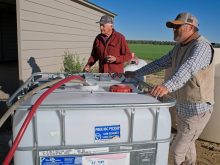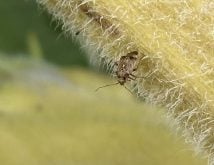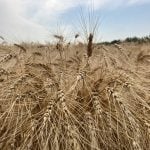The Prairie Pest Monitoring Network (PPMN) warns grasshoppers could be a problem for producers in Manitoba, Saskatchewan and Alberta if hot, dry conditions during the growing season persist into 2023.
The network’s annual grasshopper survey is conducted in late summer and early fall by estimating the density of adult insects, usually in ditches along cereal fields, that are capable of laying eggs before winter.
High densities indicate a higher risk of grasshopper outbreaks the following year, although it’s no guarantee as cool and wet growing conditions have a negative effect on the insect’s development. As the PPMN’s 2022 density map shows, all three Prairie provinces had areas with high grasshopper pressure.
Read Also

Cancer agency reclassifies another herbicide ‘probably carcinogenic’
The WHO’s cancer research agency has now put atrazine, a herbicide well known to corn growers, in the same potential-hazard category where the agency put glyphosate.
“Recent dry conditions across the central and southern prairies have been ideal for grasshoppers,” the PPMN states in its 2022 grasshopper report. “Although the area with grasshopper infestation in 2022 was similar to that observed in 2021, population densities were greater in 2022 than in 2021. More widespread outbreaks were observed in 2022 than in the last few years.”
With grasshopper populations on the rise, the PPMN says, “Prairie farmers should be prepared to scout for grasshoppers in spring and early summer in 2023, especially if weather conditions remain warmer and drier than normal.”
Grasshoppers, of course, aren’t the only bug farmers need to be wary of. With that in mind, we asked provincial experts in each Prairie province to list some of the top insect pests to look out for in 2023.
Manitoba
Grasshoppers
According to John Gavloski, an extension entomologist with Manitoba Agriculture, two-striped grasshoppers are the dominant grasshopper species in Manitoba and pose the biggest threat.

“What makes them of greater concern is the fact that they are such generalists and populations have been high in recent years.”
Gavloski says places with lots of lush, green vegetation at the end of the 2022 growing season, such as along field edges and in ditches, would have been more attractive for grasshoppers to lay eggs. He recommends farmers scout those areas thoroughly, starting in early June or so.
Flea beetles
Gavloski says flea beetles could be a concern for canola producers in 2023, based on population levels of the past few years and the fact they’re able to survive Manitoba’s harsh winters quite well.
He recommends farmers watch their canola fields closely as insects start to emerge out of the ground, typically after a few days in the 15 C range. Striped flea beetles appear first, followed by crucifer flea beetles a little later.
“They’re feeding on the very young seedling plants,” says Gavloski. “Once the plants get three or four true leaves, they can usually tolerate the flea beetle feeding. It’s at the seedling stages that people have to be very focused on scouting carefully.”
He notes insecticide seed treatments offer some protection against flea beetles, but sometimes it may not be enough.
“That seed treatment should be effective for three to four weeks, not from when the canola emerges but from the date of seeding. In some years that may be all that’s needed, but if we get conditions that extend that seedling stage for a prolonged period of time, that’s when people are at higher risk of having to do foliar sprays.”

Lygus bugs
Gavloski says lygus bugs are a pest to watch for in canola, but they can be a problem, too, in sunflower, dry bean and alfalfa seed crops if their numbers are high enough.
Adult lygus bugs overwinter in Manitoba and the insect will go through two population cycles after it emerges in the spring.
“For most crops, using a sweep net is a good way to look for them because they’re very quick and often you can’t even find them otherwise,” says Gavloski.
He recommends people scouting for lygus bugs in canola do sets of 10 sweeps. Gavloski says for a crop like confection sunflowers, though, sweep nets aren’t practical because of the size of plants. In that case, he says the best way to spot lygus bugs is by examining sunflower heads and perhaps tapping them.

Cutworms
Gavloski says cutworms are a potential pest in multiple crops in Manitoba. The two dominant species in Manitoba have been the redbacked cutworm and the dingy cutworm.
Gavloski notes while both cutworm species are generalists that eat numerous crops, the way they feed is different.
“Dingy cutworms defoliate plants and don’t do a lot of clipping, whereas redbacked cutworms, when they get big, they will clip the plants.”
Clipped plants in your crop are a clue you might have a cutworm problem, says Gavloski. He adds it’s not that easy to locate the insects during the day since they’re nocturnal.
“They will come out at night to do their feeding, so you have to dig around a bit to find them.”

Saskatchewan
Grasshoppers
James Tansey, Saskatchewan Agriculture’s provincial insect management specialist, says warm and dry conditions last July and August really helped to promote egg laying, “so we could see some grasshopper issues in the coming season.
“That comes with a bit of an asterisk. The long-term forecast into this spring is indicating cool conditions, which can slow their development. It’s not going to dramatically reduce populations, but it could slow them down a bit.”
Tansey stresses there are 85 species of grasshoppers in the Prairies and the vast majority of them are not pests. “A good mantra for growers is, ‘If it has wings in the spring, it’s not a pest,’” he says.
According to Tansey, the main pest species to watch for in Saskatchewan are two-striped, clear-winged, lesser migratory and Packard’s grasshoppers.
“Two-striped is our prevalent species in the province. This one is a little bit more generalized, but it does prefer broadleaf plants,” he says. “We do have occasional or limited populations of clear-winged, which is a cereal specialist. These seem to be primarily in areas with sandy soils.
“We have some reports of lesser migratory in southern regions, especially in the Regina area where they were relatively common. These ones are broad generalists, so there’s very little as far as plants that they won’t eat,” Tansey adds. “There are some reports of Packard’s in the Saskatoon area, and these ones are legume specialists.”

Tansey says all of Saskatchewan’s pest grasshoppers overwinter as eggs and start emerging typically in mid-May or a little later.
“In early June you’ll start to see large numbers of them, and that’ll give you an estimate as to what’s going on in your fields. Look at ditches as well, because a lot of eggs are laid in ditches,” he says.
“Look at them early and evaluate your population of (grasshopper) nymphs. When they first emerge, that is not the time for control (measures), unless they’re actually causing significant damage. That’s because a lot of things can happen to juvenile grasshoppers.”
Tansey maintains the time to start considering foliar insecticide applications for pest grasshoppers is when they’re at the third instar nymph stage, when wing buds begin to form and their numbers are nearing economic thresholds for spraying.
“That’s when you’re going to get the best bang for your buck.”
Wheat midge
According to Tansey, there is “an elevated risk of wheat midge in several parts of the province, so that is a concern.”
He says wheat midge populations typically peak around Canada Day in Saskatchewan, so it’s important to scout wheat fields for the insect around late June and early July.
Tansey notes if conditions are dry in April and May, this could delay their development and emergence from the ground by up to six weeks, but “if timely rains do occur, then that’ll stimulate them to complete their development.”
Flea beetle
Tansey says it’s important for growers to anticipate flea beetle pressure due to very large numbers of striped and crucifer flea beetles in recent years.
“We have no reason to believe that won’t be the case again this coming spring, although cool conditions could slow them down,” he says. “Unfortunately, we don’t have much in the way of predictive power for these animals (but) we don’t anticipate a reduction in flea beetle pressures this year.”
Tansey says under warm conditions striped flea beetles will start emerging as early as mid-April and into mid-May, while crucifer flea beetles typically start to appear a couple of weeks later.
“That is something to consider if you’re in a region that has been dominated by striped flea beetles,” he says. “You’ll want to start scouting a little bit earlier.”
Bertha army worm
Tansey says this is another pest canola producers in Saskatchewan should be mindful of in 2023. He stresses an important thing to remember about bertha army worm is that it’s a cyclical pest.
“It usually cycles every six to eight years. The last minor outbreak we had was about 2016, so we’re getting to be about due for an increase in these populations,” he says. “We’ve seen a slight increase in trapping numbers, so we’re going to keep an eye on that one.”
According to Tansey, peak emergence for bertha army worm is typically sometime in late June or early July, “but it’s all temperature dependent and that’s why we monitor for them.”
Saskatchewan Agriculture tracks bertha army worm moth counts during the growing season. The data, which is found at https://www.saskatchewan.ca/business/agriculture-natural-resources-and-industry/agribusiness-farmers-and-ranchers/crops-and-irrigation/insects/bertha-armyworm-map, can help farmers determine when to start scouting for bertha army worms.
Alberta
Grasshoppers
Shelley Barkley, an insect survey technologist with Alberta Agriculture, says conditions in southern Alberta have set the stage for a probable surge in grasshopper numbers.
“Going into 2022, we had some healthy populations of grasshoppers in the south, and the dry conditions of 2022 really favoured them. Then we had this beautiful long fall where they were able to lay lots and lots of eggs,” says Barkley.
“Those eggs were able to develop right to the edge of their development stage they could do before winter sets in and stops them. So if conditions are right in the spring, we could see an early grasshopper hatch.”

Barkley recommends farmers start looking for grasshoppers the last part of May and into June, and that they scout ditches and along field edges first.
The most problematic species on Alberta farms, according to Barkley, are typically two-striped, migratory and clear-winged grasshoppers.
She notes there’s a grasshopper pest in the Peace region in northwestern Alberta called Bruner’s spur-throated grasshopper that could pose problems for producers if conditions are right this year. That’s because the insect has a two-year life cycle, and odd-numbered years like 2023 are when its population tends to rise.
Flea beetles
Barkley notes flea beetles are a perennial canola pest for Alberta farmers.
“Anybody growing canola knows they have to be scouting and that they need to know what their action threshold looks like.”
Barkley says flea beetles emerge in April and May hungry and ready to feast on canola early, at the cotyledon stage, after overwintering in areas with long grass, under trees, etc.
“We had a healthy population going into the fall, and that means we could very well have a healthy population just waiting for that baby canola. But if the spring is good and there’s good moisture and the canola can get out past (the flea beetles), they won’t be as big of a concern,” she says.
Wheat midge
Barkley says wheat producers in the areas east of Edmonton between Vermilion and Viking should be aware high wheat midge numbers last year mean the insect could be a concern this growing season.
“Late June and onwards is when you can expect to have to deal with them,” she says. “If your wheat is at the susceptible stage, you are going to want to do some scouting for them and know your threat level,” she says.
Wheat stem sawfly
Barkley says wheat stem sawfly is another cereal pest farmers need to watch for, particularly in the southeastern corner of the province.
Surveys indicated the insect was more spread out than usual in that part of Alberta last year, she says. Therefore, if 2023 sees another hot, dry summer, wheat stem sawfly could be a problem.
Resources for farmers
Prairie producers can get weekly updates on problem insects in their areas this growing season through the Prairie Pest Monitoring Network. Farmers can also find the PPMN’s final insect survey results for the three Prairie provinces for 2022 at prairiepest.ca.
Here are some other resources farmers can use for scouting and management tips, as well as to assess insect threat levels in their areas:
- Alberta Agriculture offers insect scouting tips for farmers and agronomists at alberta.ca/field-scouting.aspx. It also has some instructional scouting videos, such as “Identifying and Scouting Wheat Midge” on YouTube.
- “Grasshoppers in Saskatchewan” is a recorded webinar by James Tansey that can help farmers identify different grasshopper species. Access it at attendee.gotowebinar.com/recording/7809907373792439307.
- Manitoba Agriculture has fact sheets on insect pests.
- Up-to-date research and insect reports are available on the Western Forum on Pest Management website.
- Field Heroes publishes a free Pests and Predators Field Guide that shows farmers how to identify and manage insect pests and how to identify and protect beneficial insects.
















